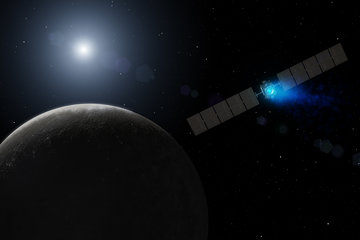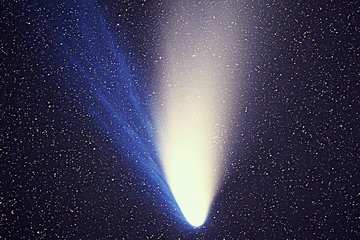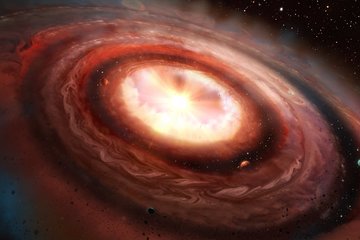New star appears in the constellation Northern Crown
A huge thermonuclear explosion 2700 light years away makes the nova T Corona Boralis visible to all in the night sky
On xx.xx.2024, a new star appeared to the south-west of the constellation Northern Crown (Corona Borealis), which will disappear again just a few days later. Are they distant Morse signals? In fact, humanity is witnessing a huge thermonuclear explosion 2700 light years away that repeats itself every 80 years. Max-Planck Researchers have been waiting for this moment because, unlike the last event in 1946, they now have powerful telescopes to study the celestial spectacle at all wavelengths. Their aim is to understand how protons are accelerated as they race through space at almost the speed of light.

It was an early autumn evening in 1217 when Burchard von Biberach, abbot of the Swabian monastery of Ursberg, spotted a wonderful sign in the starry sky. It could have been the recurring nova eruptions of the T Corona Borealis (T CrB) system - a nova every 80 years. On xx.xx.2024 it happened again and south-west of the constellation of the Northern Crown it seems as if a new star has appeared out of nowhere. At that time, the telescope had not yet been invented. Today, astronomers from all over the world point their telescopes at the object at different wavelengths and capture not only visible light, but also light from the infrared to the X-ray and gamma range. "We now have a whole month to study the gamma-ray emission of the nova," says David Green, a scientist at the Max Planck Institute for Physics.
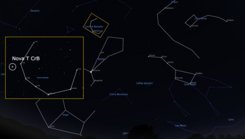
Cannibalism with consequences
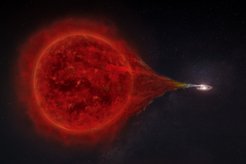
Also thanks to observations of other novae, strictly scientific data paint a clear picture today. T CrB is neither an astrological sign nor a single star, but a double star system consisting of a red giant and a stellar corpse, a white dwarf. The dance around their center of mass is so close that one orbit takes only 228 days. In the beginning, two stars with similar properties as the sun must have orbited each other in a binary star system. When the fuel supply in their interior ceased, both expanded to form red giants. One of the two has had more time to evolve and has ejected its stellar shell. What remains is a star full of carbon and oxygen, a thousand to ten thousand times smaller than the red giant. Even though the appearance of the two stars is very different, they still weigh about as much as the sun. The white dwarf combines this mass in just one per cent of its original diameter. A teaspoon of the white dwarf weighs about a ton and the difference in density between the red giant and the white dwarf is comparable to that between construction foam and lead.
A hydrogen bomb of astronomical proportions
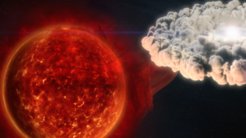
While the two stars orbit each other, the red giant forces its greatly expanded hydrogen envelope onto the tiny star in such a way that the strong tidal force causes hydrogen to flow onto the white dwarf. At a certain point, the pressure and temperature under the newly formed stellar envelope become high enough and the hydrogen-gas mixture explodes in a sudden thermonuclear fusion reaction - a hydrogen bomb of astronomical proportions. The white dwarf survives, and shortly after it has overeaten, a thin stream of matter forms again between the red giant and dwarf star. The cycle begins anew – until the next eruption in 80 years. The white dwarf and its companion cannot be separated visually from Earth, which is why it seems as if a new star has formed. Last time this happened was in 1866 and 1946. Due to the nova the system appeared more than a thousand times brighter than usual and from a distance of "only" 2700 light years, it is clearly visible to the naked eye. Novae themselves are not uncommon; every year, several dozen novae light up somewhere in the Milky Way. In many cases, however, the light does not reach Earth. The luminous phenomenon only lasts a few days until the ejected shock wave obscures the light of the explosion and the maximum brightness explosion has passed.
Regular hiccups
The faster matter flows onto the white dwarf, the hotter it gets on the dwarf’s surface and the faster hydrogen fusion ignites. In the case of the nova RS Ophiuchi (RS Oph), it flares every 15 years (it last made headlines in 2022). T Corona Borealis, on the other hand, takes its time and accumulates enough fuel over the 80 years period that the following explosion releases around ten times more energy than in the case of RS Oph. "It remains controversial whether the white dwarf in T CrB ultimately accumulates mass, or whether it even loses more mass in the explosions than it receives from the red giant", says Brian Reville from the Max Planck Institute for Nuclear Physics. Other systems don’t show recurring explosions and accumulate mass in a stable way. This would go well until a mass limit of 1.44 solar masses is exceeded and the white dwarf is torn apart in a glittering supernova.
Mini-Supernovae
Novae are perfect miniature models for supernovae. "With a supernova, everything is more powerful," says David Green. "The shocks are faster, many times more energy is released and significantly more material is hurled into the interstellar medium. But the underlying physics is the same as for a nova." With one significant difference: in a supernova, the star is destroyed. They occur extremely rarely and take place over thousands of years. "In a nova, we can follow the same processes in fast motion", says Green. This produces high-energy gamma-ray radiation, which researchers at the Max Planck Institute for Physics aim to observe with the Magic and LST-1 telescopes on La Palma. Researchers at the Max Planck Institute for Nuclear Physics will also make an observation attempt with its H.E.S.S. gamma telescopes in Namibia, hoping for good conditions. However, the position of the nova in the African sky will be almost too low, which may affect the taking of the data. The gamma rays are a hundred billion times more energetic than visible light and open up a window into the most powerful moments of the nova, when a shock front and its magnetic field sweeps through the surrounding matter.
How cosmic particles are accelerated

These shocks presumably serve as natural particle accelerators in which protons reach enormous energies. When the particles hit gas of the red giant in the neighborhood, gamma rays are produced. Protons that are propelled in such shocks could also reach the Earth. The Earth's atmosphere is exposed to a constant stream of such cosmic rays (in this case: particles), some of which had to be accelerated to relativistic speeds somewhere in space. How exactly is still unclear.
By focusing their sensitive instruments on T CrB, the scientists hope to come one step closer to solving the mystery. "T CrB is special primarily due to its proximity to Earth", says Brian Reville. In contrast to the nova RS Oph, which is two to three times more distant, in the case of T CrB they expect a much higher influx of high-energy gamma rays and therefore data of the highest quality. "We hope to be able to use the data to answer one of the oldest unsolved problems in astronomy, namely how the particles are accelerated in astrophysical shocks," says Reville.
Researchers in a state of excitement
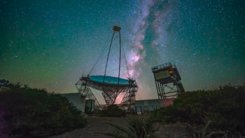
Even though the nova was to be expected, the exact time of the explosion was unknown. Over the past few months, scientific experiments and amateur astronomers have therefore been watching the sky with bated breath to make sure they do not miss the eruption. "Regardless of whether the nova sighting is reported by a satellite mission such as Einstein probe or another device, we are alerted: be it digitally or by telephone, during the day or in the middle of the night", explains David Green. "We can swivel the telescopes into the correct position within a very short time - a process that only takes around 30 seconds."
It is admittedly rare for something to really explode in the starry sky in such a way that astronomers drop everything for it. At the Haus der Astronomie in Heidelberg, schoolchildren can experience what this exciting moment feels like. "Science lessons at school focus on the basics," says Carolin Liefke. "But following current research or even contributing to it yourself is of course much more exciting." Carolin Liefke is deputy head of the Haus der Astronomie and supervises a team of youngsters who want to take part in Jugend Forscht with their findings about the nova. Since the "Astronomers Telegram" platform sounded the alarm, they have been waiting for observation conditions good enough to point a spectrograph at the nova, which is mounted on a telescope. There won't be a detailed photo of the nova, as no telescope on Earth is big enough for that. Nevertheless, there is a lot of information hidden in the spectra the group will take - a cosmic detective game. The spectra will likely show a forest of lines that can be assigned to individual chemical elements. The data will show that it is not a mysterious sign, but two stars orbiting each other, and that something is moving towards us at more than a million miles per hour as a result of the explosion. One thing is certain, even before the data has been analyzed: The explosion took place at a safe distance.
BEU/BW
Background Information
The energy of cosmic gamma rays, which researchers measure with gamma ray telescopes, ranges between a few Gigaelectronvolts and Teraelectronvolts. This is light among the highest energies that could be measured from space to date. The frequency of a light wave at an energy of 1 Gigaelectronvolt corresponds to over two hundred billion Terrahertz. For comparison: Visible light has only a few hundred Terrahertz radio waves a few Gigahertz.
H.E.S.S. stands for High Energy Stereoscopic System. It is a system of imaging atmospheric Cherenkov telescopes that investigates cosmic gamma rays in the energy range from tens of Gigaelectronvolts to tens of Terraelectronvolts. The telescopes observe gamma rays indirectly via Cherenkov radiation, which is emitted by air showers of secondary particles triggered in the Earth's atmosphere by incoming cosmic gamma rays. The name H.E.S.S. goes back to Victor Hess, who received the Nobel Prize in Physics in 1936 for his discovery of cosmic radiation.
Magic stands for Major Atmospheric Gamma Imaging Cherenkov Telescopes and consists of two gamma-ray telescopes as part of the Roque de los Muchachos Observatory on the Canary Island of La Palma at an altitude of around 2200 meters. It consists of two dishes with a diameter of 17 meters which, like H.E.S.S., are covered with mirrors to reflect the Cherenkov light into a highly sensitive camera. The energy range covered is similar to that of H.E.S.S..
LST-1 (Large-Sized Telescope) is the first telescope of the CTAO (Cherenkov Telescope Array), a major international project in gamma-ray astronomy. The aim is to create two networks with hundreds of gamma-ray telescopes at two locations: In the north on La Palma and in the south in the Atacama Desert in Chile. The aim is to increase sensitivity by an order of magnitude compared to previous gamma-ray telescopes such as Magic or H.E.S.S. LST-1 has a diameter of 23 metres and covers a similar energy range to Magic and H.E.S.S.














